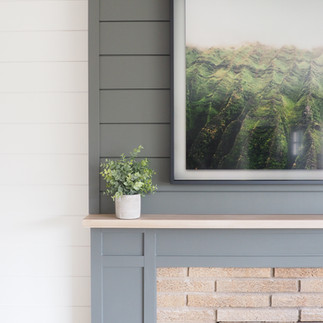The Science of Layout in Design, Why Some Spaces Just Feel Right
- Amanda Arcone
- Dec 13, 2024
- 3 min read

Have you ever walked into a room and immediately felt at ease? Perhaps the furniture placement seemed effortless, the flow of the space natural, and the overall vibe harmonious. What you were experiencing is the result of thoughtful layout design—a delicate balance of science and art that can transform a space from chaotic to calm.
Understanding layout design principles helps explain why some rooms feel "right" and others feel off. For me, the design phase always begins with understanding our clients' spaces' balance, flow, and proportions, all key elements that contribute to functional and aesthetically pleasing spaces.
Balance: Achieving Visual Harmony
Balance in interior design is about distributing visual weight evenly throughout a space. When a room feels lopsided, it often needs more equilibrium. There are three main types of balance to consider:
Symmetrical Balance: Commonly seen in traditional designs, this type relies on mirroring elements on either side of a central axis (e.g., matching sofas flanking a coffee table). It creates a sense of formality and order.
Asymmetrical Balance: This approach uses differing objects of similar visual weight to create a more dynamic, contemporary feel. For example, pairing a large sofa with a tall floor lamp can achieve balance without perfect symmetry.
Radial Balance: Arranging elements around a central focal point, such as a round dining table with chairs, creates a sense of completeness and harmony.

Flow: Guiding Movement Through the Space
Flow refers to easily navigating a room without obstacles or awkward paths. A well-designed layout considers traffic patterns and creates a natural sense of movement.
Clear Pathways: Ensure enough space between furniture pieces to move comfortably. Avoid placing large items in high-traffic areas.
Furniture Placement: Arrange pieces to encourage interaction, such as seating clusters for conversation or clear sightlines to focal points like a fireplace or window.
Connection Between Spaces: Open-plan homes benefit from layouts that guide the eye seamlessly from one area to the next. Using rugs, lighting, or furniture groupings to define zones helps maintain flow without creating barriers.




Proportion: The Relationship Between Elements
Proportion is about the scale and size of objects in relation to each other and the room. A mismatched proportion—like a massive sectional in a small living room—can make a space feel cramped or disproportionate.
The Rule of Thirds: Borrowed from art, this principle divides a space into thirds (vertically and horizontally) to create balance. For example, hanging artwork one-third above a sofa and leaving two-thirds below creates visual harmony.
Furniture Scale: Choose pieces that fit the room's dimensions. Opt for larger furniture in larger rooms to avoid a "floating" effect, while smaller spaces benefit from multi-functional, compact designs.
Ceiling Height Considerations: Taller furniture and vertical design elements like drapery or bookcases can balance the scale in rooms with high ceilings.
Practical Tips to Optimize Your Layout
Start with the Focal Point
Identify the room's focal point—a fireplace, window, or artwork—and design around it. Anchor your layout by orienting furniture to emphasize this feature.
Experiment with Arrangements- Be bold and try different furniture configurations.
Use Rugs to Anchor Zones- Area rugs define seating areas and create boundaries in open-concept spaces while adding warmth and texture.
Prioritize Functionality- A beautiful layout means little if it's not practical. Consider how you'll use the room daily and prioritize function over aesthetics when necessary.
Layer Lighting- Enhance flow and balance with a mix of ambient, task, and accent lighting to draw attention to key areas and ensure no space feels neglected.
The science of layout design may seem subtle, but its impact on how a space feels and functions is profound. If you're struggling, this may be a good opportunity to bring in a professional. We thoughtfully apply balance, flow, and proportion to our designs, creating beautiful and intuitive rooms. Whether you're designing a cozy reading nook or a spacious living area, remember that great layouts don't just happen—they are carefully crafted with intention and expertise.
When a space is designed with these principles, it doesn't just look right—it feels right. That's the power of a well-executed layout.
Need help?
Reach out to amanda@newenglandhomeandinteriors.com

















Comments